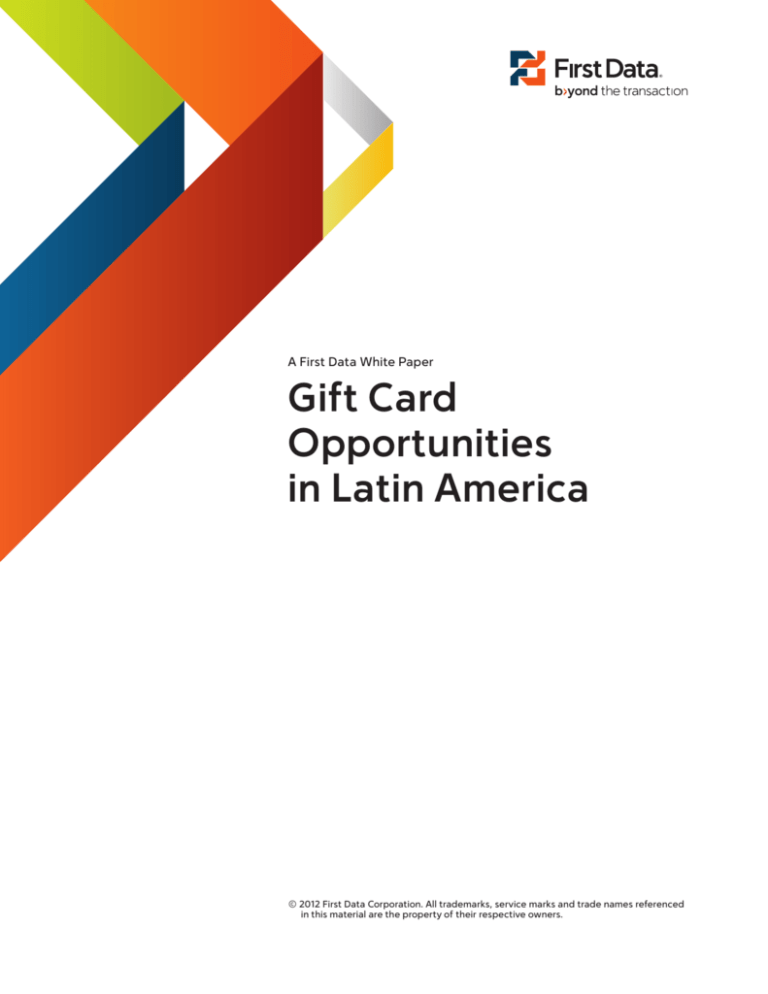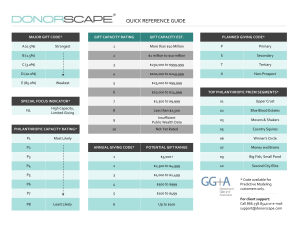
A First Data White Paper
Gift Card
Opportunities
in Latin America
© 2012 First Data Corporation. All trademarks, service marks and trade names referenced
in this material are the property of their respective owners.
Gift Card Opportunities in Latin America
A First Data White Paper
Introduction
“The gifts that one receives for giving are so immeasurable that it is almost an injustice to accept
them.” This line of a Rod McKuen poem captures the cultural significance of gift giving in most
Latin American countries. Gifts are not about cost or brand or convenience. They represent the
giver’s emotional connection to the recipient. Success in gift giving also reflects profoundly on the
giver’s character. It seems givers get as much—or more—from the process as recipients.
This deep reverence for gift giving, combined with lower-than-average awareness
of gift cards, appears to have limited the adoption of gift cards in Latin America.
While Americans, Europeans and other populations have gravitated to the
convenience and practicality of gift cards, Latin American consumers have not
While gifts card sales enjoy
strong popularity in most
parts of the world, they are
broadly incorporated them into their gift giving practices.
in the early adoption
A 2012 study commissioned by First Data and conducted by Millward Brown
examines cultural preferences relating to gift giving and Internet purchase
behaviors in Brazil, Chile, Costa Rica, Guatemala and Mexico—and provides
new insights for driving gift card sales. The study, which used focus groups to
stages throughout most of
Latin America.
gather qualitative data, showed that while each country has its unique cultural
A new study sponsored by
preferences, common themes emerged across the entire region.
First Data, however, indicates
that moving past the early
Objectives of the study included developing:
adoption stage may only
•
Understanding of cultural beliefs and habits related to the purchase of gifts
require more astute cultural
•
Awareness of prepaid card usage
understanding of gift giving
•
Evaluation of new approaches to gift card design and marketing
•
Evaluation of electronic and mobile alternatives to traditional gift cards
•
Insight into Internet purchase habits and preferred forms of payment
firstdata.com
in the region.
©2012 First Data Corporation. All rights reserved.
2
Gift Card Opportunities in Latin America
A First Data White Paper
Attitudes towards gift giving
First Data’s study revealed details of what is generally known about Latin American culture: gift giving, including wrapping
and presentation, is a highly personalized and thoughtful gesture that borders on an art form.
Consumers from all five countries participating in the study uniformly confirmed the existence of an affective component
and a social component to the gift giving experience. The most common affective components are appreciation, love
and gratitude. The most common social components include celebration, commitment and thankfulness. While these
components seem common to most cultures, the difference with Latin American consumers is their ability to translate
those abstract emotions into a tangible, physical gift.
While specifics vary from one country to another, one important finding is that the emotional and personal nature of gifts
is prevalent for all situations. It does not matter if the gift-giving event is spontaneous or planned, informal or ceremonial,
celebratory or obligatory. This consistency and pervasiveness aligns with the McKuen verse noted earlier—the success of
the gift giving matters as much, or perhaps more, to the giver.
The process tends to remain consistent across genders. The study showed, however, that Latin American women see gift
giving as an opportunity for enjoyment and sharing of emotion—an opportunity to convey emotion. Men view gift giving
as an opportunity to convey status, and take a slightly more practical approach to gift selection.
Preferred payment methods and prepaid cards
The Latin American prepaid card market totaled $20 billion (USD) in 2011, compared to more than $200 billion in the
United States, according to research from the TowerGroup, a U.S. based financial consultancy.i
The smaller prepaid market, according to the study sponsored by First Data, can be partially attributed to the fact that
Latin American consumers believe that credit and debit cards are more practical and safer than prepaid cards. Also, the
use of debit cards and cash provide better budget management and control. In the five countries participating in the
study, many consumers were simply not aware of prepaid cards or were not aware of where they might be offered. In
some countries, there is strong awareness of prepaid cards for telephony, transit and grocery applications, but little in the
way of gift cards.
A recent forecast by the TowerGroup predicts prepaid card use in Latin America—which includes gift cards—will grow
from its current $20 billion level to more than $110 billion by 2021.ii This growth will be driven by a variety of factors ranging
from increased familiarity to changing perceptions in terms of security, flexibility and cultural fit.
i
ii
Interne Partners in Prepaid, “Processors Eye Latin American Prepaid Market,” February 20, 2012.
Ibid.
firstdata.com
©2012 First Data Corporation. All rights reserved.
3
Gift Card Opportunities in Latin America
A First Data White Paper
Emerging Gift Card Opportunities
Gift card positioning and consumer response
The relatively slow sales of gift cards—and prepaid cards in general—in Latin America seems to be driven largely by a
simple lack of awareness. While some more generically designed and positioned gift cards clearly do not align with the
art of gift giving in Latin America, more customized or personalized cards would likely fare much better.
To test these notions, participants in the First Data study were shown examples of gift cards and provided with
descriptions of how they would be positioned in the market. Gift cards were positioned as appropriate for a range of
occasions, including birthdays, weddings, graduations, engagements, retirements and the birth of a child. Respondents
were informed they could buy cards at their favorite stores, restaurants or entertainment venues in any denomination.
Also, they were told there would be no expiration dates and cards could be used to purchase any product or service
available at the merchant location.
Cards featured designs that were customized to the occasion and ranged from simple and elegant to vibrant and eyecatching. Respondents were asked to rate their excitement for and interest in the sample cards presented. Responses
ranged from 1-10, with 1 representing “Not At All Interested” and 10 representing “Very Interested.” Consumer responses
in Brazil, Costa Rica and Guatemala averaged 8 on the scale of 1-10. In Mexico and Chile, where the gift cards are more
common and, therefore, less novel, responses averaged just above a 6 on the scale of 1-10. Scores were slightly higher
with men than women, because of their aforementioned more practical attitudes towards gift giving.
Reponses in all five countries to the sample gift cards—along with the current condition of low awareness—seem to
confirm the TowerGroup projection for fast growth for gift cards and other prepaid products in Latin America. The factors
holding back growth appear to be lack of awareness and lack of alignment with specific Latin American gift giving
behaviors. Accordingly, the keys to success may be thoughtful design of the cards (to align with cultural preferences) and
improving awareness regarding availability, security and convenience.
Summary of consumer thoughts on gift cards
Consumers participating in the study were asked to articulate their perceived “pros and cons” of giving gift cards for a
variety of special occasions. The pros were consistent across all five countries in the study:
•
Personalized Practicality. If the giver knows the receiver has an affinity for a particular merchant, gift cards offer a
combination of expedience and customization. In other words, gift cards offer the right kind of practicality.
•
Receiver’s Choice. Respondents liked that people receiving gifts can actually choose the exact product or service
they want. The ability to choose the right merchant and the right card design seem to make up for any perceived
lack of originality.
•
Receiver Resonance. The ability to give gifts that truly delight receivers is important in Latin American cultures. Gift
cards are seen as ways of ensuring resonance with the receiver, as they can choose the precise product or service
they desire.
•
Truly “Solidary.” Occasions such as the birth of a child call for “solidary” or economically helpful gifts. Respondents
saw gift cards as a natural way of ensuring the money they spend is truly helpful to the receiver.
•
Redemption Flexibility. Respondents are aware that new products are introduced with greater and greater
frequency in today’s market. If they have no expiration dates, gift cards allow receivers to get the exact products
they want, even if they are not on shelves the day the gift is given.
firstdata.com
©2012 First Data Corporation. All rights reserved.
4
Gift Card Opportunities in Latin America
A First Data White Paper
The cons noted by respondents centered on gift cards that were perceived as “too ordinary.” Cards with generic designs
were viewed unfavorably. Other cons mentioned included cards with overly restrictive redemption options and relatively
short expiration dates. Some respondents also cited lack of novelty and the perception of being overly practical as
potential drawbacks. One way for merchants to overcome this is to position gift cards as “a little something extra” to
supplement a traditional gift purchase.
The concept of using e-gift cards, social media and smart devices for delivery met with little enthusiasm among
respondents. Email is seen as an unsecure method of delivery—and viewed as unreliable because of the prevalence
of spam. Mobile phones are perceived as relatively unsecure and generally awash with other types of communication.
Facebook and other social media sites are viewed more as gaming or socializing venues and not optimal for conducting
transactions or delivering items of value.
The power of card design and packaging
Respondents in the study clearly like the gift card attributes of expedience while shopping for gifts and the flexibility
accorded when recipients select the exact products or services they want. These attributes, however, only seem to hold
enough appeal when the cards—and potentially the packaging around the cards—offer the personal touch that comes
with custom or highly relevant designs.
A variety of card designs were presented to respondents as part of the study. While the preferences for card designs
varied by country, age group and gender, one finding was clear—consumers like choices. Offering multiple card designs
or the possibility of custom card printing elevates gift cards in the eyes of many Latin American consumers and directly
addresses concerns of cards being overly practical or impersonal. Similarly, providing attractive, occasion-specific
envelopes and carriers increases the appeal of gift cards—especially if these wrappers provide space for givers to write a
personal message. Any opportunity to add personality and warmth to the gift is considered a highly valued attribute.
generic green
Traditional Mass Produced Gift Cards
generic green
generic swirl
Latin American consumers tend to balk at gift cards that feel common or
feature designs that do not relate to specific gift-giving occasions.
generic swirl
firstdata.com
©2012 First Data Corporation. All rights reserved.
5
Gift Card Opportunities in Latin America
A First Data White Paper
wedding
birthday
Occasion-Specific Gift Cards
christmas
wedding
birthday
The ability to link card designs and wrappers with the gift-giving occasion resonates with Latin American consumers
christmas
newborn
soccer tournament
Event-Specific Gift Cards
my daughter
newborn
birthday
christmas
soccer tournament
happy father’s day
Designs that feature seasonal or topical events elevate gift cards above the ordinary and rate better with Latin American consumers.
my daughter
our graduate
Recipient-Specific Gift Cards
newborn
cinco de mayo
soccer tournament
my daughter
our graduate
our loyal customer
Designing and producing cards for specific recipients can make customize gift cards more inviting for Latin American consumers.
cinco de mayo
our loyal customer
our graduate
firstdata.com
©2012 First Data Corporation. All rights reserved.
6
Gift Card Opportunities in Latin America
A First Data White Paper
Final Recommendations
The results of our study convey one overriding reality—
retailers that can align their gift card programs with the
preferences of Latin American consumers could find
themselves at the forefront of a high-growth opportunity. It
appears that Latin American consumers are not resistant to
the concept of gift cards. Rather, some have simply not been
made aware of gift cards, while others have resisted more
generic gift cards designs that were originally developed
for—and successful in—other cultures and other markets.
Clearly, gift giving in Latin America is a highly personal
experience with deep emotional implications for both the
giver and receiver. Developing gift card products and card
designs that are attuned to this cultural reality appears to be
the key to enjoying what is predicted to become a $110 billion
market within the next decade.
Personalized Cards and Packages. Remember that
are less appealing in Latin America.
Personalized Delivery. Adding space to write a personal
message to the receiver (on the card carrier or even the
card itself) aids in receptivity—as does providing a highquality envelope or special card carrier.
Promotional Bundles and Cross Sales. Gift cards hold
appeal when they are incorporated into a gift package
that includes traditional items, such as flowers or
chocolates. Likewise, gift cards can be positioned as a
timely add-on to a physical gift (e.g., to accompany an
MP3 player or e-book reader)
•
regarding Internet shopping. This data was collected
because gift cards can be sold and redeemed online.
Consumers in Latin America have been less enthusiastic
about making Internet purchases than many other
parts of the world. The survey sponsored by First Data
shows Internet shopping is still in an early expansion
period. One reason for slower adoption is consumers’
skepticism regarding Internet security of personal financial
information. Costly shipping is another prohibitive factor.
majority views the Internet primarily as a tool for socializing.
United States, the United Kingdom and other markets
•
qualitative data regarding attitudes and preferences
physically examining an item before purchasing it—and a
standard off-the-shelf designs that are popular in the
•
The study conducted by First Data also gathered
In addition, Latin American consumers tend to prefer
Key to a successful program include:
•
Internet Purchase Habits of
Latin America Consumers
Representative Designs. Leverage card design and printing
technology to reflect the special gift-giving occasions that
In terms of Internet users, approximately 39.5 percent
of Latin Americans are connected to the Internet in their
homes or at work, compared to a worldwide average of
32.7 percent. By contrast, 78.6 percent of consumers in
North America and 13.5 percent of consumers in Africa
are connected at home or work. Percentages in the
countries participating in the study ranged from a high
of 43.7 percent of connected consumers (Costa Rica) to
16.5 percent of connected consumers (Guatemala).1
A majority of consumers who are connected, however,
have tended to make some kind of Internet purchase at
least once over the past year. Those percentages range
from 72 percent of Internet users in Chile to 30 percent
of Internet users in Guatemala.2
hold great meaning for Latin American consumers.
•
Linkage with Other Consumer Programs. Leverage gift
cards for loyalty programs, daily deal redemption and
other applications.
•
1
2
Internet World Stats, August 2011.
Tendencias Digitales en Latinoamérica 2011.
Reloadable Capability. Magnetic stripe and smart
card technologies also provide the option of issuing
reloadable gift cards. This long-term usability may hold appeal for many consumers.
firstdata.com
©2012 First Data Corporation. All rights reserved.
7
Gift Card Opportunities in Latin America
A First Data White Paper
The Global Leader in
Electronic Commerce
Around the world every day, First Data makes payment transactions secure, fast and easy for merchants, financial
institutions and their customers. We leverage our unparalleled product portfolio and expertise to deliver processing
solutions that drive customer revenue and profitability. Whether the payment is by debit or credit, gift card, check or
mobile phone, online or at the point of sale, First Data helps you maximize value for your business.
Study Methodology
Mercaplan (a Latin American division of Millward Brown) conducted qualitative research on First Data’s behalf.
Focus groups were held in five Latin American countries using local, experienced moderators:
{{
Costa Rica
{{
Guatemala
{{
Mexico
{{
Chile
{{
Brazil
•
Five groups in each country
•
90-minute discussion per group
•
8-10 participants each
•
Focus groups held in January/February 2012
firstdata.com
©2012 First Data Corporation. All rights reserved.
8
2778
•







